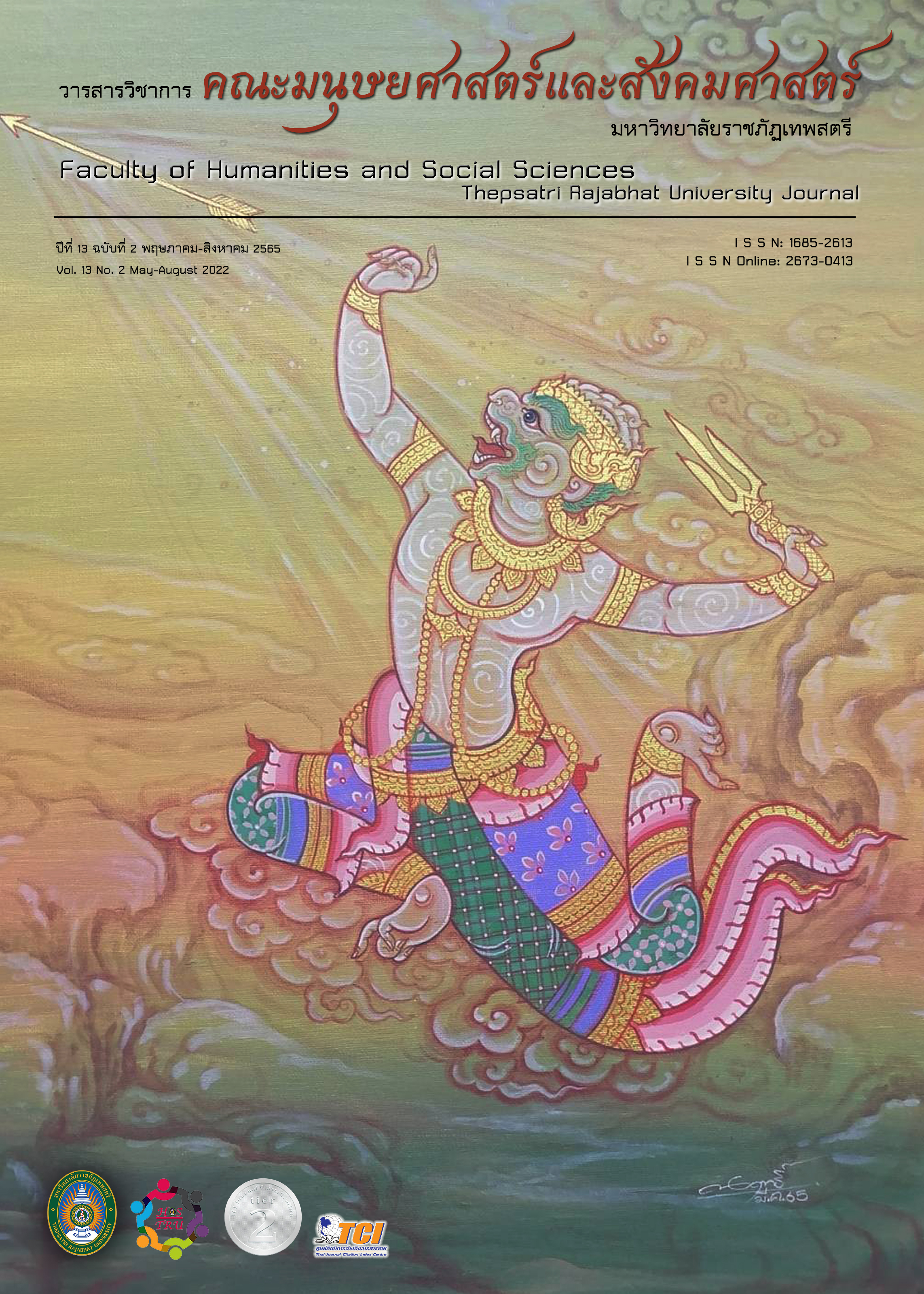Spatial Thinking Skills: A Skill Needed to Learn Geology
Main Article Content
Abstract
Spatial thinking skills is a necessary skill for understanding of trends and changes that happened between geographical phenomena with time. Which the geographic phenomena can happen from many of reasons. Including the changes of the world which happen all the time. The study of geology will give us to know when the world changes. It will cause trouble to humans and other creatures very quickly. We necessary to study and understand the process of changing the world. We will be prepared to cope with the changes in the world that will occur in the future. Spatial thinking skills will make understand and can connect the relationship of the area with the surrounding area and the effects resulting from changes in the area. We can be analyze, evaluate, prevent and solve problems that arise or predict to occur precisely in order to be safe from geographical phenomena or geological phenomenon. As well as increasing efficiency in solving problems in daily life. It will lead to design and develop useful tools in the field of geology.
Downloads
Article Details

This work is licensed under a Creative Commons Attribution-NonCommercial-NoDerivatives 4.0 International License.
The content and information presented in articles published in the Academic Journal of the Faculty of Humanities and Social Sciences, Thepsatri Rajabhat University, are solely the opinions and responsibilities of the respective authors. The editorial board of the journal neither necessarily agrees with nor assumes any responsibility for such content in any manner whatsoever.
All articles, information, content, and images published in the Academic Journal of the Faculty of Humanities and Social Sciences, Thepsatri Rajabhat University, are the copyright of the journal. Any person or organization wishing to reproduce, disseminate, or otherwise utilize all or any part thereof must obtain prior permission from the Academic Journal of the Faculty of Humanities and Social Sciences, Thepsatri Rajabhat University.
References
กรมทรัพยากรธรณี. (2550). เอกสารประกอบภาพ ชุดที่ 1 ธรณีวิทยาและทรัพยากรธรณีประเทศไทย (พิมพ์ครั้งที่ 2). กรุงเทพฯ: สำนักธรณีวิทยา กรมทรัพยากรธรณี.
กิจการ พรหมมา. (2555). ธรณีวิทยาสำหรับวิศวกร. กรุงเทพฯ: สำนักพิมพ์แห่งจุฬาลงกรณ์มหาวิทยาลัย.
ชัยวัฒน์ สุทธิรัตน์. (2550). 80 นวัตกรรม การจัดการเรียนรู้ที่เน้นผู้เรียนเป็นสำคัญ. พิษณุโลก: โรงพิมพ์พิษณุโลกเปเปอร์.
เลเกีย เขียวดี. (2555). การพัฒนารายวิชาภูมิศาสตร์กายภาพสำหรับครูเพื่อส่งเสริมทักษะการคิดเชิงพื้นที่สำหรับนักศึกษาโปรแกรมวิชาสังคมศึกษา คณะครุศาสตร์ มหาวิทยาลัยราชภัฏกำแพงเพชร. การค้นคว้าแบบอิสระปริญญามหาบัณฑิต มหาวิทยาลัยเชียงใหม่.
สำนักวิชาการและมาตรฐานการศึกษา. (2560). ตัวชี้วัดและสาระการเรียนรู้แกนกลาง สาระภูมิศาสตร์ (ฉบับปรับปรุง พ.ศ.2560). กรุงเทพฯ: โรงพิมพ์ชุมนุมสหกรณ์การเกษตรแห่งประเทศไทย จำกัด.
สถาบันส่งเสริมการสอนวิทยาศาสตร์และเทคโนโลยี. (2556). หนังสือเรียนรายวิชาพื้นฐาน โลก ดาราศาสตร์ และอวกาศ. กรุงเทพ: โรงพิมพ์ สกสค.ลาดพร้าว.
อภิชาติ ลำจวน, และเบ็ญจา เสกธีระ. (2557). หินเปลือกโลก. ในสารานุกรมไทยสำหรับเยาวชนโดยพระราชประสงค์ในพระบาทสมเด็จพระเจ้าอยู่หัว ฉบับเสริมการเรียนรู้ (เล่มที่ 20). กรุงเทพฯ: ด่านสุทธาการพิมพ์ จำกัด.
Achmad Nur Hidayaht, Sarwono, & Yasin Yusup. (2017). Earthcomm - based Multimedia Learning of Geography in Improving Learning Motivation and Spatial Ability of the High School Students. International Conference on Teacher Training and Education 2017 (ICTTE 2017), 158, 1 – 10.
Alec M., Bodzin. (2011, March). The Implementation of a Geospatial Information Technology (GIT)-Supported Land Use Change Curriculum With Urban Middle School Learners to Promote Spatial Thinking. Journal of Research in Science Teaching, 48(3), 281 – 300.
Hauptman, H., & Cohen, A. (2011, November). The Synergetic Effect of Learning Styles on The Interaction Between Virtual Environments and The Enhancement of Spatial Thinking. Computers & Education, 57(3), 2106 - 2117. Doi: https://doi.org/10.1016/j.compedu.2011.05.008.
Jeffrey T. H., & Sintona, D. (2011). Sequencing Spatial Concepts in Problem-based GIS Instruction. Procedia - Social and Behavioral Sciences, 21, 253 - 259. Doi: https://doi.org/10.1016/j.sbspro.2011.07.042.
Jongwon Lee, & Robert Bednarz. (2011). The Components of Spatial Thinking: Empirical Evidence. Procedia Social and Behavioral Sciences, 21, 103–107. Doi: https://doi.org/10.1016/j.sbspro.2011.07.048.
Kim A. Kastens, & Toru, Ishikawa. (2005). Spatial Thinking in The Geosciences and Cognitive Sciences: A Cross-Disciplinary Look at the Intersection of the Two Fields. Lamont-Doherty Earth Observatory and Department of Earth and Environmental Sciences, Columbia University.
Kristoffer B., Berse. (2011). Beyond Geo-spatial Technologies: Promoting Spatial Thinking Through Local Disaster Risk Management Planning. Procedia Social and Behavioral Sciences, 21, 73 – 82. Doi: https://doi.org/10.1016/j.sbspro.2011.07.037.
Minori Yuda. (2011). Effectiveness of Digital Educational Materials for Developing Spatial Thinking of Elementary School Students. Procedia - Social and Behavioral Sciences, 21, 116 -119. Doi: https://doi.org/10.1016/j.sbspro.2011.07.045.
Stacy Rebich Hespanha, Fiona Goodchild, & Donald G., Janelle. (2009). Spatial Thinking and Technologies in the Undergraduate Social Science Classroom. Journal of Geography in Higher Education, 33(Supplement 1), S17–S27. Doi: https://doi.org/10.1080/03098260903033998.
Ridha, S. (2019). Evaluating Disaster Instructional Material Questions in Geography Textbook: Using Taxonomy of Spatial Thinking to Support Disaster Preparedness. IOP Conference Series: Earth and Environmental Science, 273, 1 – 8. Doi: https://10.1088/1755-1315/273/1/012035.
Rogow. (2002). ABCs of Media Literacy: What Can Pre-Schooolers Learn?. Retrieved February 15, 2021, from http://www.medialit.org/reading-room/abcs-media-literacy-what-can-pre-schooolers-learn.
Single Gateway. (2558). แจงแค่ศึกษา “ซิงเกิล เกตเวย์”. Retrieved February 15, 2021, from https://shorturl.asia/gfn03.


